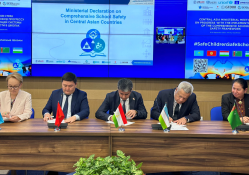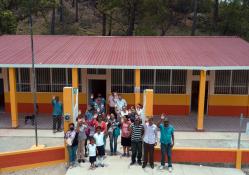Launched in 2014, the Global Program for Safer Schools (GPSS) is funded by GFDRR. It builds on the experience and lessons learned from World Bank projects that financed important investments in safer school infrastructure in Colombia, the Philippines, and Türkiye. GPSS aims to boost large-scale investments to improve the safety and resilience of school infrastructure at risk from natural hazards and enhance the quality of learning environments for children.
As well as benefiting from the experience of other World Bank projects, GPSS draws on lessons learned from its own country engagements worldwide, in line with the World Bank’s global efforts to support resilient infrastructure and the human capital project. Through this program focused on school infrastructure, the World Bank is contributing to the efforts of the Global Alliance for Disaster Risk Reduction and Resilience in the Education Sector (GADRRRES) and to other endeavors emerging from global agreements under the Sendai Framework for Disaster Risk Reduction.
Every year, the impacts of disasters and climate change around the world affect children’s education. By damaging or destroying school infrastructure, disasters directly harm students, teachers, and the school community. Further harm comes in their aftermath, when the community is exposed to physical and mental stress that interferes with school operations, teaching, and learning. Efforts to bring children back to school and achieve the full recovery of education services are prolonged, often by lengthy processes for emergency response, recovery, and reconstruction. In the face of these challenges, resilient school infrastructure is vital to ensuring the quality of learning environments.
GPSS has four main objectives:
• to build evidence-based knowledge and tools to inform large-scale investments that will improve the safety and resilience of school infrastructure;
• to promote and facilitate the integration of risk reduction criteria into school infrastructure investments;
• to provide technical advice to developing countries designing medium-term school infrastructure plans; and
• to support the resilient recovery of school infrastructure affected by natural hazard events and climate change.
Highlights
Knowledge
The Global Library of School Infrastructure (GLOSI) is a global repository of evidence-based knowledge and data about school infrastructure. It includes a global catalogue of school building types, vulnerability information and solutions to improve safety and resilience of school infrastructure at scale. Using a standard taxonomy, the GLOSI is a live library that is enhanced over time from safer school activities worldwide.
The Roadmap for Safer and Resilient Schools (RSRS) is a step-by-step guide intended to provide support to governments of developing countries exposed to natural hazards. Specifically, it focuses on the design of intervention strategies and investment plans to make schools safer and resilient at scale. The scope of the guide encompasses the recovery and reconstruction of school facilities affected by disasters.


